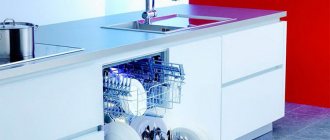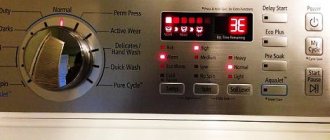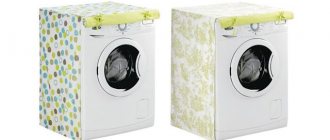Planning a kitchen space is not an easy task. When the apartment does not have large areas, you have to look for non-standard solutions to the situation. For example, what to do if there is no place for the washing machine in the bathroom? Of course, install it in the kitchen. Indeed, a washing machine in the kitchen is far from uncommon. This article will discuss the most convenient placement options and all the important features of planning such an installation.
Placing a washing machine in the kitchen will be the best solution for a house or apartment with a small bathroom
How to install a built-in washing machine: features, methods
A washing machine is a necessary equipment in every home, but it is not always possible to find a suitable place for it. Usually the unit is installed in the bathroom, but if there is a shortage of space in the bathroom, the device can be placed in the kitchen or even in the hallway. The best solutions for small spaces are to integrate the washing machine under the countertop, under the sink or into the kitchen unit. Next, we will consider in which room it is better to install the machine, whether it is possible to build in full-sized equipment, and what needs to be taken into account when connecting the device to communications.
Which machine is suitable for embedding?
Having decided on the location in the house, you can start choosing a washing machine. From the point of view of the possibility of embedding, units are divided into three groups: full-size (free-standing), with the possibility of partial embedding and fully built-in. You can successfully fit even a full-size model into the interior by choosing the optimal method.
The easiest way to install a built-in washing machine. Usually it is installed in a specially designated niche in the kitchen unit. The upper part is covered with a table top and plays the role of a lid, and the front part is hidden behind a panel or door attached to special hooks and fasteners - in such models they are provided by the manufacturer.
A fully built-in washing machine looks most harmonious in the kitchen interior
If the unit has the designation “with the possibility of embedding” in its characteristics, it does not have fastenings on the front panel. Such models are equipped only with a removable top cover. The machine can be installed in a kitchen unit, and the door can be attached not to the body of the appliance, but to the side walls of the furniture. A full-size unit is placed under a countertop or in a kitchen cabinet, if the furniture can be adjusted to the parameters of the device.
When choosing a washing machine for both the kitchen and bathroom, most buyers are guided not by the possibility of embedding, but by the dimensions of the model.
Today, the household appliances market offers a large number of compact models of washing machines. Narrow machines with a depth of no more than 32-45 cm are popular. You can also find a model with a height of no more than 65 cm, which allows you to build the equipment under the sink in the bathroom.
When choosing a washing machine, you should also pay attention to the way you load laundry. There are models with vertical or front loading. The first option is compact, because their width is approximately 20-25 cm less than that of standard frontal models. But, unfortunately, it is irrational to build vertical machines into a kitchen set, because their upper part cannot be covered with a stationary countertop and used as a work surface. Alternatively, you can make a folding tabletop, as shown in the photo below.
This is what a top-loading machine looks like, built under a folding tabletop
Where is the best place to install a washing machine?
Washing. The machine in the kitchen is most often installed near the sink. This is the most convenient location; hoses of minimal length are used leading to the water supply and drainage. If the machine is installed far from the sink, some parts will wear out faster because more power will be needed to move water over long distances. You will have to choose hoses up to 5 or 7 m long.
Options for installing the machine in the interior:
- Installation under the countertop without a door;
- Location behind the facades and under the countertop;
- Built into a cabinet;
- Stationary location.
Article on the topic: Where to go for repair of washing machines in the boiler room
Which car is better to choose
If you have a large kitchen and unlimited financial possibilities, then there will be no problems with choosing a machine. You can choose any one, depending on your personal preferences, and smoothly fit it into the interior of the kitchen. But for small kitchens, choosing a washing machine is always a problem, since you not only need to find a place for it, but also hide it.
Frontal or vertical
The difference between these two types of washing machines is that laundry is placed in the vertical washing machine from the top, and in the front washing machine from the front, from the front side. Both machines perform the same function of washing dirty laundry. A front-loading machine is more convenient for the kitchen, as it is more convenient to put things in and take them out. But if we talk about safety, then water can spill out of the front-loading machine if there is a malfunction, and in the event of a breakdown, only a master can open the unit.
Dimensions and dimensions
When choosing the size of a washing machine, the buyer always focuses on the place where it will be placed, whether it will be located separately or built into the kitchen unit. In order to place the machine, built into furniture, the optimal choice would be a 40-45 cm model, this is the standard width of the tabletop. A machine of this size will fit flush against the wall. If the equipment will stand separately, then you can choose an option adapted to the size of the kitchen.
You should also take into account that a heavy machine will be stable and will not shake or vibrate.
Built-in or free-standing
As you can see, it was not by chance that the washing machine was in the kitchen; it was all due to the small size of the room. To save kitchen space, built-in appliances are used. Many models of washing machines are already designed to be built-in, which makes them easy to use - there are no problems with pulling out and closing the powder tray, for example. Also, such units already have fasteners on which you can hang a decorative door. Built-in machines have standard sizes suitable for kitchen units (unless, of course, you buy custom-made furniture). The machine, with a depth of 57 cm, a width of 60 cm and a height of 85 cm, fits perfectly into a standard kitchen set.
Many people buy a freestanding machine because it is cheaper and build it into furniture. As a result, the equipment is placed too deep into the wall, which causes access problems. If you move the machine forward, along the line of the set, then there will be a large gap between it and the wall, and during washing not only the unit, but also the set with dishes and food will vibrate.
The ideal low-budget option is to buy a free-standing machine and order a cabinet with a tabletop to match its size, taking into account the interior of the kitchen.
Bathroom furniture with built-in washing machine
A built-in cabinet for a washing machine in a bathroom usually involves installing a sink above it. This can only be done with an offset. Since the height of the washing machine and its depth do not allow installing a siphon, organizing drainage and water supply.
Thanks to the emergence of ready-made “washing machine + sink” solutions, you can manage the free space in the bathroom quite rationally without any additional cabinets or countertops.
The only drawback of this duo is the small capacity of the reduced-height washing machines. Therefore, most people prefer to build a washing machine in the bathroom into a cabinet that resembles part of a kitchen unit with a sink.
The size of such a module depends on the dimensions and model of the sink. Bathroom furniture with a built-in washing machine will take up minimal space if you give preference not to mortise and overmount sinks, but to the so-called “water lily” sinks. There are models on sale with larger platforms that will “cover” the washing machine like a countertop.
Quite compact bathroom furniture with a built-in washing machine is obtained by using glass sinks. With a bowl diameter of about 400-450 mm, the length of the module can be only 900 mm.
With more space at your disposal, it makes sense to implement two-level structures.
Lowering the countertop at the level of the sink is ergonomically more correct and allows people with shorter than average height and children to wash themselves comfortably and perform other hygiene procedures.
Positioning the Top Loading Machine
Installing appliances in a small top-loading kitchen is inconvenient, but even here the design solutions are well thought out.
Remember that the washing machine vibrates during operation.
Two options are being considered:
- Manufacturers of the headset make a separate table for an individual washing machine. Thus, two issues are resolved, the equipment fits into the interior, while the table fully functions as an additional work area.
- The machine is built into a common wall, but the top of the tabletop or part of it is folded.
Article on the topic: How to remove the control unit of an Ariston washing machine
The first and second ideas solve the aesthetic and functional problem of placing equipment in a compact room. The rest depends on the personal preferences of the customer.
Integrate into furniture
The most popular and common move is to install the unit in a niche in the headset. Moreover, household appliances often look very stylish and do not violate the overall harmony of the design. This technique is also acceptable in a small kitchen - the work surface becomes larger, and the total area is reduced slightly.
There is, perhaps, only one limitation - it will not be possible to install a top-loading washing machine this way.
Important: If the machine vibrates strongly during spinning, do not try to cut anything over it at this moment. This is fraught with injury.
Pros and cons of placing a washing machine in the kitchen and tips for using it
Placing a washing machine in the kitchen is most often a necessary measure, which has its pros and cons. Let's start with the positives.
- In addition to freeing up space in the bathroom, you will create an additional work surface in the kitchen. Another bonus for a large family is the ability to do laundry at any time, regardless of whether the bathroom is busy or not.
However, when moving the machine to the kitchen, you need to be prepared to put up with some inconveniences:
- The noise of the machine during spinning and draining will interfere with communication during meals and drown out the TV.
- The smell of washing powder and other cleaning chemicals is not very appropriate and useful where food is stored, and where household members eat and relax.
- To wash dirty clothes, you will first have to look into the bathroom (or another room where the laundry basket is stored), sort and load everything you need into a basin, grab the required portion of powder along the way, and only then proceed to the kitchen.
However, all these inconveniences are not critical and can be completely solvable. Here are some tips to help you quickly get used to the kitchen-laundry area.
- To prevent noises and smells from disturbing you during gatherings in the kitchen, try to start washing clothes at night/evening or in between meals.
- It is best to store washing powder either in a closet in containers with a tight lid (say, under the sink), or in another room altogether (in the same bathroom, for example).
- To prevent the powder from spilling past the tray every now and then, simply replace it with liquid laundry detergent, which, by the way, always dissolves completely.
- To make the machine make as little noise as possible, adjust its legs well.
- If you're building your kitchen from scratch, try to use ceramic tiles/porcelain flooring rather than laminate or hardwood flooring. After all, firstly, it is not afraid of possible leaks, and secondly, it minimizes the noise of the machine during washing.
Article on the topic: How to wash a sweatshirt in a washing machine
Features of placing a washing machine in a kitchen of 6 sq.m.
Soviet architects did not even imagine that decades later household appliances would become an integral part of people's lives. Famous kitchen 6 sq.m. in the so-called Khrushchev buildings requires a lot of imagination in interior design. Therefore, it is very difficult to squeeze a washing machine into such an area. All design tricks to save space are used. After all, in addition to the washing machine, you also need to place a refrigerator, gas stove and other electrical appliances in the room. Optimal options:
- Install the machine in one of the cabinets under the tabletop;
- Place the equipment under the sink;
- Hide the washing machine in a niche under the window, standard for Khrushchev apartments.
Definitely, the machine should be hidden so as not to violate the idea of the interior design and, thereby, not to reduce the already small kitchen area.
List of required tools
- Tape measure, level, screwdriver.
- Set of open-end wrenches (adjustable wrench).
- Screwdrivers.
- FUM tape.
- Pliers, scissors, knife, electrical tester.
It is possible to install a washing machine in the kitchen yourself. The result of the work performed to install a washing machine depends on the kitchen design, which must take into account the desired dimensions of the device. In small rooms, it is important to correlate the size of the device with the usable volume of the floor cabinets.
Location features for a small kitchen
In Khrushchev, where there is often not enough work space, the washing machine should be placed under the work area. The washing machine in a small kitchen is covered with a facade or placed openly - the main thing is that it fits in size.
The photo shows the placement of the washing machine next to the sink
In a corner kitchen set, it is convenient to place the machine near the sink on the other side of the stove and oven. The linear layout also suggests a place for the washing machine at the sink, separated by a section from the hob.
Do not place electrical appliances or other items on the countertop above the washing machine; they may fall and be damaged due to vibration.
Options for installing a washing machine
Behind the façade and under the countertop
This is the most common way to install a washing machine. It closes completely. In front are kitchen cabinet doors, on top is a countertop.
With this option, the washing machine does not violate the style of the interior.
If your kitchen has a carefully thought-out design, the furniture and accessories are in the same style, and the flooring harmonizes well with the curtains, it would be a pity to ruin it with an inappropriate type of electrical appliance. In such a situation, the option of being built into a cabinet is the most optimal.
When installing, it is important to remember that different electrical appliances must be placed separated by at least one cabinet compartment.
This facilitates the correct operation of the devices. If the dimensions of the kitchen do not allow this condition to be met, ensure good thermal insulation for each appliance. Remember that the washing machine vibrates during operation.
Leave gaps between its surface and the cabinet walls.
Under the countertop, but without a door
In some cases, a washing machine will look appropriate in the kitchen even without a masking door.
This option is suitable for rooms with a minimalist design, for example, in a high-tech style.
Options look advantageous when, for example, the refrigerator, washing machine, hood and oven door are designed in a single metallic shade.
Kitchen cabinet handles of the same shade can emphasize the unity of style.
Another option to successfully fit the machine into the kitchen interior under the countertop, without resorting to embedding it in a cabinet with doors, is to use a special film for pasting.
Article on the topic: How to use the Zanussi flv 504 nn washing machine
They come in different colors and patterns and can be matched to kitchen wallpaper or furniture.
If necessary, the washing machine can also be simply painted in a suitable color. In addition, it is possible to order the decor of household appliances according to individual wishes from specialized companies in order to obtain a successful combination of the machine and the kitchen set.
Built into a cabinet
With this option, the washing machine is not placed on the floor, but occupies the middle compartment of the cabinet. There is a cabinet underneath it. Above it is another compartment of the kitchen cabinet. From a design point of view, there are the same features as in the previous version: it looks organic in a laconic design, and additional decor can be used if necessary.
This method has additional advantages - you can choose the height of the device to suit your needs.
Now you don't have to squat or bend over to load and remove laundry. In addition, this is an excellent option in terms of rational use of kitchen space - the space both above and below the machine remains functional.
Recommendations for choosing a location
A built-in washing machine is convenient, practical and aesthetically pleasing. This technique allows you to rationally use the space of the room and not spoil the design of the kitchen. But before you build the machine into furniture, you need to think about a convenient option for its placement.
Closed with countertop and facade
In most cases, the washing machine is completely hidden in one of the kitchen cabinets. The door is attached to canopies that are already installed on the equipment. But, if we are talking about an ordinary free-standing washing machine, then you can order exactly the same cabinet from a construction shop, taking into account the size of the equipment. Advantages of complete closure by the countertop and facade:
- The washing machine does not spoil the appearance of the room with its presence;
- Thus, space in the kitchen is saved - the countertop is used for preparing food;
- If you have small children in the house, you can put a lock on the door.
The back of the machine is not covered by the facade - this ensures air circulation and the ability to connect to communications.
Hidden in a cabinet
If we are talking about an ordinary free-standing washing machine, then you can order exactly the same cabinet from a construction shop, taking into account the size of the equipment. Your guests will not even realize that there is a washing machine in the kitchen. This method will protect the machine from dust and dirt, and will also provide excellent sound insulation.
Under the countertop or sink
A very common option for placing the machine is under the countertop. This way, only the front-loading model can be positioned. Convenience lies in the fact that the settings panel and the washing hatch are always visible, and you can control the washing process. The disadvantages of this arrangement are that it is not aesthetically pleasing – the machine is conspicuous. Also, the equipment will collect dust and dirt on itself, and small children can easily mess with the settings and damage the machine.
You can place the washing unit under the sink. This is very convenient, since the cabinet under the sink is usually empty. Also a big plus is the proximity of communications. But in this case, the cover of the machine will interfere with installation, then it is removed. Also, in order for the machine to fit, you need to choose a shallow sink - the “water lily” type, where the drainage system is located behind the machine, is ideal. This will ensure safety in the event of a breakthrough or other malfunction.
The disadvantage of placing equipment under the sink is that you need to pull out the machine every time the plumbers visit if, for example, the sink becomes clogged. Given the large dimensions and considerable weight of the equipment, this is inconvenient.
Washing machine in the kitchen under the countertop
A kitchen with a washing machine is more common in country houses, where they usually save on bathroom space, leaving more square meters for the kitchen-living room.
A washing machine built under the countertop in this case is the most successful location option from the point of view of both convenience and aesthetics. The main difficulty is related to the fact that the equipment must be connected to communications (water supply and sewerage).
First of all, we will consider machines with a front loading type, because... they are best suited for under-counter installation. But there is another type - with vertical loading. This option will require a folding countertop, but sometimes for a kitchen with a non-standard layout this can be the most successful solution. We will consider all the nuances regarding top-loading machines in a separate paragraph below.
Article on the topic: How to wash jeans in a washing machine without dyeing them
Stationary accommodation
When placed permanently, the device is not covered with a countertop. The equipment is placed in any free space. The sides of the washing machine are not covered by a façade. It is open on all sides.
The permanent installation option is economical. There is no need to think about making a box with a door.
The easiest way. I placed the devices in a free place and connected them to communications. Nothing more needs to be done.
The only thing is that you need to order a kitchen set of such length that the appliances will fit.
For stationary placement, try to ensure that the washing machine is closer to the sink.
If the kitchen has already been installed, and you decide to purchase appliances later, you will have to buy a smaller model. Its dimensions should be such that it fits into the remaining space. Machines with vertical and front loading are suitable for permanent installation.
DIY installation
Installing a washing machine built into a kitchen cabinet or under a countertop is quite simple and anyone can do it. It is performed in several stages.
- The mounting bolts are removed from the newly purchased machine and plugs are installed in their place.
- Connection to water supply. To do this, install a tee or fitting on the central cold water supply pipe, to one outlet of which a kitchen faucet is connected. A shut-off valve is attached to the second outlet of the tee, which must be closed after each wash so that the unit is not constantly under water pressure. Next, connect the machine’s filling pipe, which comes complete with the mounting coupling.
- The machine can be connected to the central sewer system in several ways:
- installing a special siphon on the sink with a drain pipe and a check valve for draining the machine;
- by installing a tee at the sewerage outlet point and connecting the machine’s outlet pipe to it through a seal;
- Any automatic washing machine is equipped with a plastic holder into which the outlet hose is attached. In this form, the hose can be installed on the sink and waste water can be drained. This method of draining water is the easiest to install, but the most unsuccessful to use. After all, pouring dirty water and powder into the sink where dishes and food are washed is not hygienic.
- The connection to the power supply can be carried out either directly to a separate line or to an outlet connected through an RCD device.
- When all communications are connected to the machine, it is installed in a cabinet or under a countertop. Now it is important to set it strictly to the level in order to minimize the likelihood of vibration during operation. This is done by twisting the adjustable legs with constant control of the building level. In the desired position, the machine is fixed by pressing the fastening nuts on the legs close to the body.
Attention! The washing machine is installed in the kitchen so that access to all communications and the filter on the front of the machine is free.
- If a built-in model of a washing machine is installed, at the last stage the door mount is screwed to its body.
Article on the topic: What do the icons on the Atlant washing machine mean?
A built-in washing machine brings convenience, elegance and style to a modern kitchen. Such a design and technical solution will allow you to competently plan the usable area of the apartment. Bringing this idea to life is not at all difficult and anyone can do it.











